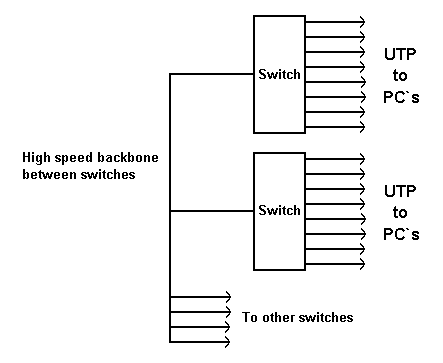Layer 3 switching
Development of layer 3 switches
The section of this website entitled "Networks" described the use of switches as a development in technology which superseded hubs.
Hubs allowed the use of twisted pair cable instead of snaking an ethernet coax around the workplace. Switches allowed the same cable layout, but also divided up large networks into smaller segments. The computers attached to each segment could exchange large quantities of data with each other, without hogging the whole network.

This system worked well with the types of data flow that were typical at that time. In the commercial environment, it was a reasonable assumption that 80% of network traffic was very local, ie, on the same segment, and only 20% required a connection to either other segments or other networks.
However the very rapid growth of the internet and increasing dependency on servers has considerably altered this balance of traffic flow, and it is fast becoming the norm for 80% of network traffic to require a connection to another segment or network, with only 20% of traffic being contained within a segment.
The traditional concept of using bridges or routers to interconnect segments or networks has problems - conventional bridges or routers tend to be too slow. Their internal architecture is based on microprocessors with their associated software - this architecture can take a substantial time to process each packet of data, and so the bridges or routers cause bottlenecks to traffic flow.
Manufacturers such as 3Com, Cisco, and Intel therefore developed a new generation of switches which can replace both the legacy switch, and the bridges and routers.
These new switches are known as layer 3 switches, as the part of the switch which replaces the bridge or router operates at layer 3 of the OSI 7 layer model, which layer is called the Network layer.
These layer 3 switches also contain facilities to operate in the same way as legacy switches, ie, they operate at layer 2 of the OSI 7 layer model, which layer is known as the Data Link layer.
Legacy switches are sometimes referred to as layer 2 switches, since that is the layer they operate within.
Ethernet and TCP/IP
Within the real world of TCP/IP, the IP layer approximately correlates to layer 3 of the OSI 7 layer model, and so these layer 3 switches can switch at the IP level.
In addition, because they also contain layer 2 switching, they also switch at the basic Ethernet packet level, as did the legacy switches.
Internal architecture
The internal architecture of a layer 3 switch is different from that of a legacy bridge or router - instead of using a microprocessor and the associated software, layer 3 switches use ASICs, or Application Specific Integrated Circuits.
ASIC`s are much faster than microprocessor based architectures, and so using layer 3 switches considerably reduces the bottlenecks caused by legacy bridges and routers.
© 2001 Ron Turner
Return to the index page